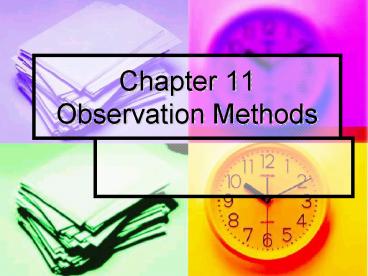Chapter 11 Observation Methods - PowerPoint PPT Presentation
1 / 10
Title:
Chapter 11 Observation Methods
Description:
Chapter 11 Observation Methods When is Observation Scientific? YOU SEE, BUT YOU DO NOT OBSERVE. Sherlock Holmes Scientific Observation is the systematic process ... – PowerPoint PPT presentation
Number of Views:625
Avg rating:3.0/5.0
Title: Chapter 11 Observation Methods
1
Chapter 11Observation Methods
2
When is Observation Scientific?
- YOU SEE, BUT YOU DO NOT OBSERVE. Sherlock
Holmes - Scientific Observation is the systematic process
of recording the behavioral patterns of people,
objects, and occurrences without questioning or
communicating with them. - There are four conditions for scientific
observation - Serves a formulated research purpose
- Planned systematically
- Recorded systematically
- Subjected to checks or controls on validity and
reliability
3
What can be Observed?
- Physical actions
- Verbal behavior
- Expressive behavior
- Spatial relations and locations
- Temporal patterns
- Response Latency is the amount of time necessary
to make a choice between two alternatives used
as a measure of the strength of preference. - Physical Objects
- Verbal and pictorial records
4
What Can Be Observed
Phenomena Example
Human behavior or physical Shoppers
movement action pattern in a store Verbal
behavior Statements made by airline
travelers who wait in line Expressive
behavior Facial expressions, tone of voice,
and other form of body language
5
What Can Be Observed
Phenomena Example
Spatial relations How close visitors at an and
locations art museum stand to
paintings Temporal patterns How long fast-food
customers wait for their order to be
served Physical objects What brand name items
are stored in consumers pantries Verbal
and Pictorial Bar codes on product
packages Records
6
Types of Observation
- Human versus mechanical observation
- Mechanical observation is situation in which
video cameras, traffic counters, and other
machines help observe and record behavior. - Visible versus hidden observation
- Visible observation is situation in which the
observers presence is known to the subject. - Hidden observation is situation in which the
subject is unaware that observation is taking
place. - Direct versus scientifically contrived
observation - Direct observation is a straightforward attempt
to observe and record what naturally occurs the
investigator does not create artificial
situation. - Contrived observation is observation in which the
investigator creates an artificial environment in
order to test a hypothesis.
7
Types of Observation
- Participant observation is situation in which an
observer gains firsthand knowledge by being in or
around the social setting being investigated. - Physical-trace Evidence is a visible mark of some
past event or occurrence. - Content Analysis is a research technique for the
objective, systematic, and quantitative
description of the manifest content of
communication.
8
Examples of Mechanical Observation
- Eye Tracking Monitor records how the subject
actually reads or views an advertisement, measure
unconscious eye movements. - Pupilometer is a device used to observe and
record changes in the diameter of the pupils of a
subjects eyes. - Psychogalvanometer is a device that measures
galvanic skin response, a measure of involuntary
changes in the electrical resistance of the skin. - Voice Pitch Analysis is a physiological
measurement technique that records abnormal
frequencies in the voice that are supposed to
reflect emotional reactions to various stimuli. - Optical Scanners and Bar Codes
9
Advantages of Observation
- Communication with respondent is not necessary
(Unobtrusive) - Data without distortions due to self-report
(e.g. without social desirability) Bias - No need to rely on respondents memory
- Nonverbal behavior data may be obtained
- Certain data may be obtained more quickly
- Environmental conditions may be recorded
- May be combined with survey to provide
supplemental evidence
10
Disadvantages of Observation
- Cognitive phenomena cannot be observed
- Interpretation of data may be a problem
- Not all activity can be recorded
- Only short periods can be observed
- Observer bias possible
- Possible invasion of privacy































